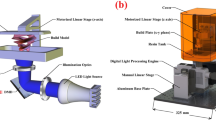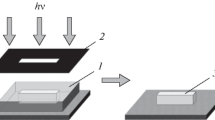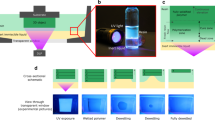Abstract
Microstereolithography (MSL) is a promising technology for producing fully three-dimensional microstructures with overhanging features and high-aspect ratios. In conventional stereolithography (SL), a layer thickness of ≈50–100 μm is obtained by using a recoater. However, a recoater cannot be used in MSL, where the layer thickness is typically ≈10 μm or less, since resin flow may break or distort the pre-fabricated layers. In most MSL systems, the resin surface (or layer thickness) is controlled by a free surface technique that employs resin gravity to refresh the resin surface over a given settling time. In addition, a sacrificial layer must be fabricated in MSL to create a flat initial surface and provide support, just as in SL. In this paper, the fabrication methodology and functionality of the sacrificial layer is investigated for microstereolithography microstructures fabricated using the free surface technique. Experimental data are presented that indicate the greater the number of sacrificial layers, the sharper the dimensional accuracy of the microstructures in the building direction. This is because multiple fabrications of the sacrificial layer affect the resin ‘wetting’ status on the substrate or pre-cured surfaces. Several microstructures were fabricated to verify the effect of multiple fabrications of the sacrificial layer on dimensional accuracy in the building direction.
Similar content being viewed by others
References
Hull, C. W., “Apparatus for production of three dimensional objects by stereography,” US Patent No. 4575330, 1986.
Ikuta, K. and Hirowatari, K., “Real three dimensional microfabrica tion using stereolithography and metal molding,” Proc. IEEE MEMS, pp. 42–47, 1993.
Katagi, T. and Nakajima, N., “Photoforming applied to fine machin ing,” Proc. IEEE MEMS, pp. 173–178, 1993.
Huang, Y. M. and Lan, H. Y., “CAD/CAE/CAM integration for increasing the accuracy of mask rapid prototyping system,” J. Computers in Industry, Vol. 56, No. 5, pp. 442–456, 2005.
Stansbury, J. and Ge, J., “Photopolymerization shrinkage and stress in resins and composites,” Radtech Report technical paper, Vol. 17, No. 3, pp. 56–62, 2003.
Huang, Y. M. and Jiang, C. P., “Curl distortion analysis during phot opolymerisation of stereolithography using dynamic finite element method,” Int. J. Adv. Manuf. Technol., Vol. 21, No. 8, pp. 586–595, 2003.
Hong, W., Lee, Y. T. and Gong, H., “Thermal analysis of layer for mation in a stepless rapid prototyping process,” Applied Thermal Engineering, Vol. 24, No. 2–3, pp. 255–268, 2004.
Choi, J. W., “Development of Projection-based Microstereolitho graphy Apparatus Adapted to Large Surface and Microstructure Fabrication for Human Body Application,” Ph. D. Dissertation, Mechanical & Intelligent Systems Eng., Pusan National University, 2007.
Choi, J. W., Ha, Y. M., Lee. S. H. and Choi, K. H., “Design of Microstereolithography System Based on Dynamic Image Projection for Fabrication of Three-Dimensional Microstructures,” Journal of Mechanical Science and Technology, Vol. 20, No. 12, pp. 2094–2104, 2006.
Ha, Y. M., Choi, J. W. and Lee, S. H., “Mass production of 3-d microstructures using projection microstereo lithography,” Journal of Mechanical Science and Technology, Vol. 22, No. 3, pp. 514–521, 2008.
Bertsh, A., Bernhard, P. and Renaud, P., “Microstereolithography: Concepts and application,” 8th IEEE International Conference on Emerging Technologies and Factory Automation, Vol. 2, pp. 289–298, 2001.
Varadan, V., Jiang, X. and Varadan, V. V., “Microstereolithography and other fabrication techniques for 3D MEMS,” JOHN WILEY & SONS, pp. 103–138, 2001.
Ikuta, K., Ogata, T., Tsubio, M. and Kojima, S., “Development of mass productive microstereolithography (Mass-IH process),” Proc. MEMS, pp. 301–305, 1996.
Ikuta, K., Maruo, S. and Kojima, S., “New Microstereolithograph y for freely movable 3D micro -structure super IH process with submicron resolution-,” Proc. IEEE MEMS, pp. 290–295, 1998.
Beluze, L., Bertsch, A. and Renaud, P., “Microstereolithography: a new process to build complex 3D object,” Proc. SPIE, Vol. 3680, pp. 808–817, 1999.
Huang, Y. M. and Jiang, C. P., “Numerical Analysis of Mask Type Stereolithography Process Using a Dynamic FINITE-Element Method,” Int. J. Adv. Manuf. Technol., Vol. 21, No. 9, pp. 649–655, 2003.
Park, I. B., Lee, S. D., Kwon, T. W., Choi, J. W. and Lee, S. H., “Fabrication of Elliptical Micro-lens Array with Large Surface Using Msl,” Journal of Korean Society for Precision Engineering, Vol. 25, No. 2, pp. 123–130, 2008.
Decker, E. L., Frank, B., Suo, Y. and Garoff, S., “Physics of contact angle measurement,” Colloids and Surface A: Physicochem. Eng. Aspects, Vol. 156, No. 1–3, pp. 177–189, 1999.
Kim, J. D., “Phenomenalism of interface,” Arche-press, pp. 25–96, 2000.
He, M., Yuan, X., Ngo, N. Q., Cheong, W. C. and Bu, J., “Reflow technique for the fabrication of an elliptical microlens array in sol-gel material,” APPLIED OPTICS, Vol. 42, No. 36, pp. 7174–7178, 2003.
Jacobs, P. F., “Rapid Prototyping and Manufacturing: Fundamentals of Stereolithography,” Society of Manufacturing Engineers, pp. 81–92, 1992.
Author information
Authors and Affiliations
Corresponding author
Rights and permissions
About this article
Cite this article
Park, IB., Choi, JW., Ha, YM. et al. Multiple fabrications of sacrificial layers to enhance the dimensional accuracy of microstructures in maskless projection microstereolithography. Int. J. Precis. Eng. Manuf. 10, 91–98 (2009). https://doi.org/10.1007/s12541-009-0014-3
Received:
Accepted:
Published:
Issue Date:
DOI: https://doi.org/10.1007/s12541-009-0014-3




